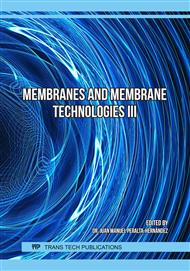[1]
L.N. Xu, J.S. He, Y. Yu, P.J. Chen, Effect of CNT content on psysicochemical properties and performance of CNT composite polusulfone membranes, J. Chem. Eng. Res. Design, (2017) 92-98.
DOI: 10.1016/j.cherd.2017.01.031
Google Scholar
[2]
J.K. Holt, H.G. Park, Y. Wang, M. Standermann, A.B. Artyukhin, C.P. Grigotopoulos, A. Noy, O. Bakajin, Fast mass transport through sub 2-nanometer carbon nanotubes. J. Sci., (2006) 1034-1037.
DOI: 10.1126/science.1126298
Google Scholar
[3]
C.M. Seah, S.P., Chai, A.R. Mohamed, Synthesis of aligned carbon nanotubes. J. Carbon, (2011) 4613-4635.
DOI: 10.1016/j.carbon.2011.06.090
Google Scholar
[4]
T. Altalhi, Carbon nanotube composites: Advanced properties for emerging applications. Adelaide: The University of Adelaide. Retrieved from The University of Adelaide, (2014).
Google Scholar
[5]
J.R. Jambeck, R. Geyer, C. Wileox, T.R. Siegler, M. Perryman, A. Andrady, R. Narayan, R. K.L. Law, Plastic waste inputs from land into the ocean. J. Marine Pollut., (2016) 31-80.
DOI: 10.1126/science.1260352
Google Scholar
[6]
A.A. Aziz, S. Ibrahim, Preparation of activated carbon/N-doped titania composite for synergistic adsorption-photocatalytic oxidation of batik dye, IOP Conf. Series: Materials Science and Engineering, 358 (2018) 012014.
DOI: 10.1088/1757-899x/358/1/012014
Google Scholar
[7]
U.R.R.P. Remli, A.A. Aziz, Photocatalytic degradation of methyl orange using Carbon Quantum Dots (CQDs) derived from watermelon rinds, IOP Conf. Series: Materials Science and Engineering, 736 (2020) 042038.
DOI: 10.1088/1757-899x/736/4/042038
Google Scholar
[8]
R.L. Narayana, M. Matheswaran, A.A. Aziz, P Saravanan, Photocatalytic decolourization of basic green dye by pure and Fe, Co doped TiO2 under daylight illumination, Desalination, 269, (2011) 249-253.
DOI: 10.1016/j.desal.2010.11.007
Google Scholar
[9]
A. Somayajula, A.A. Aziz, P. Saravanan, M. Matheswaran, Adsorption of mercury (II) ion from aqueous solution using low‐cost activated carbon prepared from mango kernel, Asia‐Pacific J. Chem. Eng, 8, (2013) 1-10.
DOI: 10.1002/apj.1613
Google Scholar
[10]
N.H. Razak, S.M. Praveena, A.Z. Aris, Z. Hashim, Drinking water studies: A review on heavy metal, application of biomarker and health risk assessment (A special focus in Malaysia). J. Epidemiology and Global Health, (2105) 297-310.
DOI: 10.1016/j.jegh.2015.04.003
Google Scholar
[11]
A. Mat Said, A. Fakhru'l-Razi, O. Mumtazah, J.C. Meow Chen, Malaysian households' drinking water practices: A case study. Int. J. of Sustain. Dev. World Ecology, (2007) 503-510.
DOI: 10.1080/13504500709469749
Google Scholar
[12]
M. Alsawat, T. Altalhi, T. Kumeria, A. Santos, D. Losic, Carbon nanotube-nanoporous anodic alumina composite membranes with controllable inner diameters and surface chemistry: Influence on molecular transport and chemical selectivity. J. Carbon, (2015) 681-692.
DOI: 10.1016/j.carbon.2015.05.090
Google Scholar




